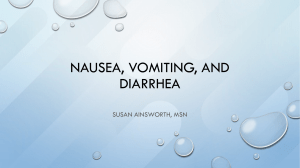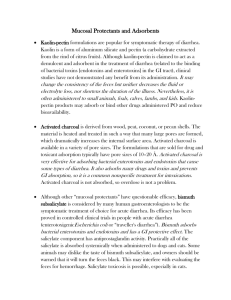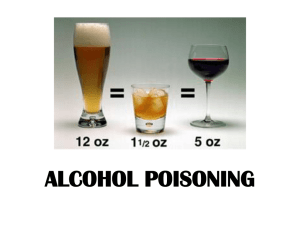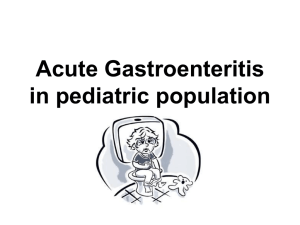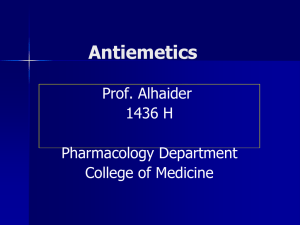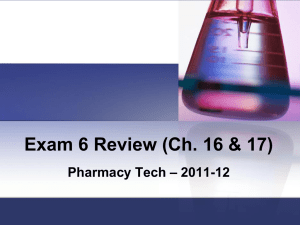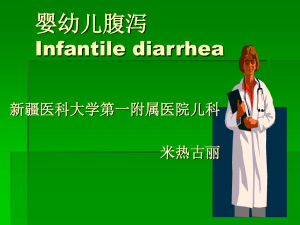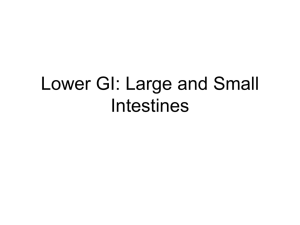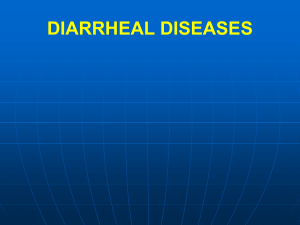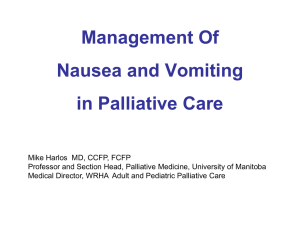Control Mechanisms of the GI Tract
advertisement
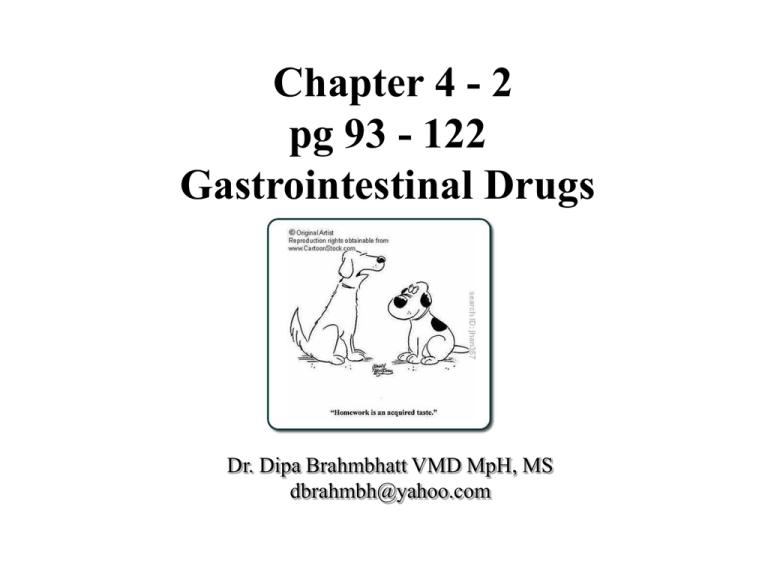
Chapter 4 - 2 pg 93 - 122 Gastrointestinal Drugs Dr. Dipa Brahmbhatt VMD MpH, MS dbrahmbh@yahoo.com OBJECTIVES • • • • • Basic physiology that controls the GI tract Mechanism of emesis and antiemetics GI motility and drugs that affect these Mechanism of GI ulcers and anti-ulcer drugs Drugs modification in the ruminant GI tract Antiemetics • Vomiting has many causes including: – Viral and bacterial infections, dietary indiscretion, food intolerance, surgery, pain, GI disease, kidney/liver failure, metabolic conditions (hypoadrenocorticism), CNS disorders or other drugs • The vomiting center of the brain have many inputs that tell it to activate including: – Equilibrium changes in the ear, responses due to pain or fear, intracranial pressure changes, vagus nerve stimulation in the GI tract, and activity in the chemoreceptor trigger zone Antiemetics • Antiemetics – Drugs that control vomiting that help alleviate discomfort and help control electrolyte balance – Most are given parenterally, as the patient may vomit the medication before it can be absorbed through the GI tract – Examples: • Phenothiazine derivatives: Acepromazine, Chlorpromazine, Prochlorperazine (Compazine) • Antihistamines: Dimenhydrinate (Dramamine), Diphenhydramine (Benadryl) • Anticholinergics • Procainamide derivatives • Serotonin receptor antagonists Antiemetics • Phenothiazine derivatives (vasodilation, hypotension) • • • • • Alpha adnergic receptor antagonist (hence vasodilates) Vomiting by motion sickness Block dopamine receptors in CRTZ and emetic center Antihistamine effects helps with motion sickness in dogs Does not stop PNS (GI, peritoneal, pharyngeal or other *visceral) effectively unless in high doses • Side effects include hypotension and sedation • Don’t use with seizure animals (exacerbates condition), vomiting animals or with abnormal GI motility • Hydration has to be good • Examples: – – – – Acepromazine Chlorpromazine: acute gastroenteritis Prochlorperazine Perphenazine Antiemetics • Antihistamines • Block H1 receptors in the CRTZ from vestibular system – Large # H1 receptor – CRTZ - dog • Controls vomiting when the vomiting is due to motion sickness, vaccine reactions, or inner ear problems • Not effective for PNS or * Vagus n. gastroenteritis • A side effect is sedation • Don’t use 4 days before allergy testing • Examples: – Trimethobenzamide (Tigan) – Dimenhydrinate (Dramamine) – Diphenhydramine (Benadryl) Antiemetics • Anticholinergics (Sympathomimetic/ parasympatholytic nervous system drugs) • Block PNS (vagus n.) - acetylcholine peripherally, which decreases intestinal motility and secretions • May decrease gastric emptying – gastric atony (which may increase the tendency to vomit) • Side effects include dry mouth, constipation, urinary retention, and tachycardia • Examples: – – – – Aminopentamide (Centrine) Atropine Isopropamide Hyoscine (scopolamine: Donnatal human product) • Useful for irritable bowel syndrome, high **** PNS Antiemetics • Procainamide derivatives or Prokinetics • Work centrally by blocking the CRTZ (dopamine (more in dogs hence better for them) and serotonin receptors) • Peripherally (prokinetic) by speeding gastric emptying, strengthening cardiac sphincter tone, and increasing the force of gastric contractions • Should not be used in animals with GI obstructions, GI perforation, or GI hemorrhage • SE: sedation (don’t use with phenothazine tranquilizers) • An example used in veterinary medicine is metoclopramide (reglan) Frenzied cat – Chemotherapeutic agents – Bile (duodenum) and mucus vomitus in otherwise healthy Dog • Prokinetics: Cisapride (Propulsid) – Serotonin antagonist effects – Cats – megacolon – Off market: human arrhythmias but available for vets in compounding pharmacies Antiemetics • Serotonin receptor antagonists • Work selectively on 5-HT3 receptors, which are located peripherally and centrally - CRTZ • Work on the theory that some chemicals cause vomiting because they increase serotonin release from small intestinal cells • Examples: – Ondansetron (Zofran): 0.5 – 0.1 mg/kg » Chemotherapy, parvovirus » $$ – Dolasetron Quinuclidine class: Maropitant (Cerenia®) Antiemetics • Neurokinin receptor antagonists – Work on NK1 receptors located in the center of the brain – Work by inhibiting substance P, the key neurotransmitter involved in vomiting • Maropitant citrate (Cerenia®) – Used to prevent acute vomiting and motion sickness – Side effects include: • Pain at the injection site, hypersalivation, and diarrhea • Extra label in cats Diarrhea – – – – – – – Diarrhea: abnormal frequency and liquidity of fecal material due to GI tract unable to absorb fluid Exudative diarrhea: protein/ fluid/ serum or blood loss in lumen Dehydration and electrolyte imbalance Decrease uptake of nutrients Muscle weakness Acid-base disturbances Causes • Infectious: bacterial endotoxins, parvovirus, transmissible Gastroenteritis - swine • Foreign body • Toxins: toxins • Inflammatory • Neoplasm • Metabolic: EPI – young shepherds • Laxatives Small Intestine Large Intestine Amount Increased (volume) Decreased Frequency (times/day 2-4 4-10 Tenesmus No Yes Weight loss +/- No Blood Melena Frank Mucous No Yes Antidiarrheals – Antidiarrheals are drugs that decrease peristalsis or increase segmental contractions, thereby allowing fluid absorption from the intestinal contents – Examples: • • • • • • Anticholinergics Protectants/adsorbents Opiate-related agents Anti-inflammatory drugs Probiotics Antibiotics/ antiparasitic drugs: Metronidazole Antidiarrheals – Modify Intestinal Motility Anticholinergics (against Ach) – used to treat tenesmus (colitis) and vomiting (colonic irritation) – Examples: • Atropine (Injectable-SA) – Not used often • • • • – anticholinergic, mydriatic, cycloplegia Aminopentamide (Centrine) Isopropamide Propantheline (Pro-Banthine) IBD Methscopolamine (Biosol-M) – Don’t use in cardiac arrhythmias, tachycardia (cathyperthyroidism), ileus, • Side effects of anticholinergics • Make SI diarrhea worse by dec. segmental contraction and resistance flow • Dry mouth • Constipation • CNS stimulation • Tachycardia • Pupillary dilation Antidiarrheals - Anticholinergics Antidiarrheal – Modify Intestinal Motility • Opiate-related agents (scheduled drugs) – Narcotic analgesics control diarrhea by decreasing both intestinal secretions and the flow of feces and increasing segmental contractions – Examples: • Diphenoxylate (Lomotil, lonox, diphenatol). C-V • Loperamide (Imodium: OTC): least CNS depression • Paregoric (tincture of opium): C-III, older drug – Side effects include CNS depression (excitement:horses & cats), ileus, urine retention, bloat, constipation and may increase contact time between pathogen and gut!!! Antidiarrheal Block Hypersecretion • Secretions from – Enterotoxins – Leukotrienes – PG – Increase affect of Ach or PNS • Pulls electrolytes and can cause severe dehydration esp. young • Can become exudative diarrhea if GI lumen is compromised >> protein loss, rbc, sugar, fluid Antidiarrheal Block Hypersecretion • Anti-inflammatory drugs – Salicylates (aspirin like compounds) • Salicylate: antisecretory by blocking PG • Bismuth in bowel: tarry stool looks like melena • Bismuth subsalicylate (bismuth + aspirin-like product) – – – DON’T USE IN CATS (no more than 24 hrs) Not specific Pepto bismol, corrective mixture (w/opium): refrigerate to increase palatability • Kaopectate: breaks in gut to bismuth carbonate (coating agent) and salicylate – Flunixine Meglumine (Banamine, flunixamine) • Mostly for colic horses • Calf scours • Not canine/feline: ulcers – Sulfasalazine (Azulfidine): sulfonamide + salicylate (mesalamine) • • • • Antimicrobial (sulfonamide) and mesalamine (anti-inflammatory) Ulcerative colitis Caution in cats Sulfa SE: vomiting (give with food), dec. tear production Antidiarrheal Adsorbents and Protectants • Protectants & Adsorbents – Protectants coat inflamed intestinal mucosa with a protective layer – Adsorbents bind bacteria and/or digestive enzymes and/or toxins to protect intestinal mucosa from damaging effects – Examples: • Bismuth subsalicylate (bismuth + aspirin-like product) – DON’T USE IN CATS – Not specific – Pepto bismol, corrective mixture (w/opium) • Kaolin (adsorb)/pectin (Kao-forte, kaopectilin) – Dec. absorption of some antibiotics and digoxin – New kaopectate: 130mg aspirin and 230 mg (extra strength) >> 1Tbsp >> toxicity 5 lb cat • Activated charcoal (toxiban, liqui-char) – Side effects include constipation Antidiarrheals • Probiotics – Probiotics seed the GI tract with beneficial bacteria; use is based on the theory that some forms of diarrhea are caused by disruption of the normal bacterial flora of the GI tract – Must be refrigerated to maintain the viability of the bacteria – Examples: • Plain yogurt with active cultures • Variety of trade-name products Probiotics Lactobacillus spp. Enterococcus faecium Bifidobacterium spp. Antidiarrheals • Metronidazole (Falgyl) – A theory regarding the development of diarrhea is that anaerobic bacteria may increase due to disruption of normal GI flora – One way to treat this is to use an antibiotic effective against anaerobic bacteria – Metronidazole is an example of an antibiotic and antiparasitic used to treat diarrhea Metronidazole • Tablets, suspension • Bitter tasting (cats hate this, foam in the back of mouth), if smash up and put in food, they will stop eating • Narrow margin toxicity: CNS problems, ataxia References • Romich, J.A. Pharmacology for Veterinary Technicians, 2nd edition. 2010. • Bill, R.L. Clinical Pharmacology and Therapeutics for the Veterinary Technician, 3rd edition. 2006.
